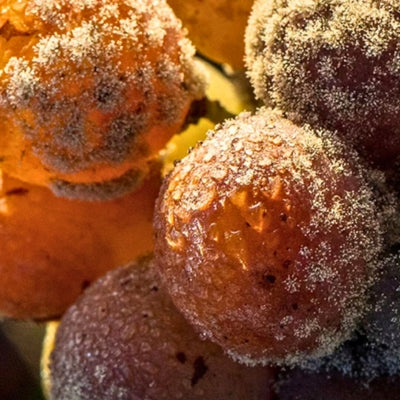
Liquid Gold Part I: Sauternes
In our latest series, Westgarth Wines wine expert Maurizio Broggi looks at noble rot and the defining style and emergence of Sauternes as we know it.
The world of wine boasts many sweet styles, but few command the reverence accorded to the legendary, luscious, and age-worthy Sauternes and Tokaji. Among the greatest sweet wines globally, these two stand apart – yet are united by their extraordinary reliance on Botrytis cinerea, the "noble rot" fungus. This miraculous mold transforms ripe grapes into shriveled, sugar-laden berries, concentrating flavors and imparting remarkable complexity.
Sauternes
Unlike other renowned sweet wine regions such as Alsace or Loire Valley where sweet wine production is a sideline to dry wines, Sauternes has built its entire identity around the painstaking creation of botrytized dessert wines of unparalleled complexity and longevity.
As early as the 18th century, Thomas Jefferson famously praised the sweet wines of Château d'Yquem, which regularly graced his table and delighted his guests. As documented by James Gabler in his book ‘Passions: The Wines and Travels of Thomas Jefferson’, the wine's characteristic style – marked by the transformative effects of noble rot – may have emerged somewhat accidentally in the 19th century. Gabler indicates that in 1847, workers at Château d'Yquem delayed harvest awaiting the return of owner Marquis de Lur-Saluces. When he finally arrived, the grapes had become overripe and affected by Botrytis cinerea. The resulting wine proved revelatory – intensely sweet, remarkably concentrated, and possessing an unprecedented depth and unique complexity of flavors. This unexpected discovery would come to define the Sauternes style.
The terroir of Sauternes
The production of great Sauternes begins with its terroir, a combination of unique geographical and climatic factors. The official appellation covers over 4,000 acres located approximately 25 miles southeast of Bordeaux. What makes this relatively small area so special is the confluence of two rivers, the Garonne and its cooler tributary, the Ciron, which creates the perfect conditions for the development of noble rot.
In autumn, the temperature differential between the two rivers generates morning humid mists that blanket the vineyards. These damp conditions activate Botrytis spores on the grape skins. As the day progresses, the mists typically burn off thanks to the afternoon sunshine, allowing the grapes to dry and concentrate. This daily cycle of moisture and warmth is crucial – without it, the grapes would simply rot rather than undergo the beneficial drying that creates Sauternes' signature flavor profile.
The process of noble rot (pourriture noble in French) is a biochemical marvel. The Botrytis fungus perforates the grape skins, allowing water to evaporate. Simultaneously, it triggers chemical changes that create new flavor compounds, resulting in the honeyed, saffron, dried stone fruit and tropical fruit notes that define Sauternes.
The grape varieties of Sauternes
While noble rot represents the defining feature of Sauternes' distinctive character, a significant role is also played by its unique blend of grape varieties: Sémillon, Sauvignon Blanc, and Muscadelle, each contributing essential qualities to the final wine.
The exact blending proportions vary by estate and vintage, however, Sémillon typically dominates plantings, accounting for about 80% of the appellation's vineyards and it is typically the major component in Sauternes blend.
This thin-skinned white cultivar proves particularly susceptible to noble rot, making it ideal for Sauternes production. Beyond its botrytis affinity, Sémillon provides richness and waxy texture creating the opulent mouthfeel that is typically associated with Sauternes. Furthermore, with time in bottle, Sémillon develops complex flavors of honeyed and toasty notes. Top châteaux such as Yquem and Climens use particularly high percentages of Sémillon in their blends.
Sauvignon Blanc plays a minor but essential supporting role, typically comprising 15-20% of the blend, as it provides vibrant acidity that balances Sémillon's richness and the wine’s intense sweetness. Sauvignon's characteristic fruity notes also add aromatic lift to the blend. A tiny amount of Muscadelle (usually less than 5%) occasionally appears in the mix, contributing floral and spicy nuances when used.
Stay tuned for Part II of our series, which explores Sauternes winemaking, communes, classifications and its future.
Want to read more? Take a look at some of our other blogs:



